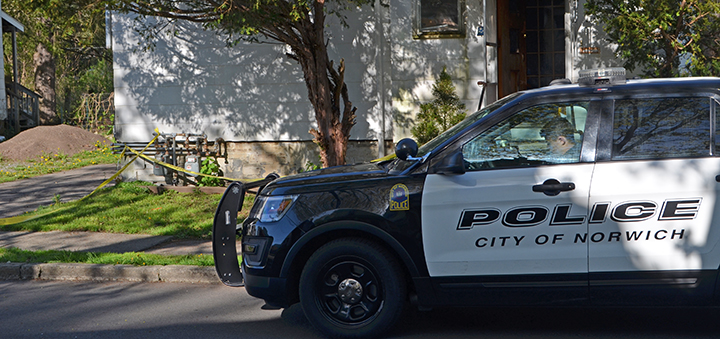Tilting At Windmills: Rat-a-Tat Tat
Published:
January 5th, 2024
By:
Shelly Reuben

After I endured a cacophony of thwacks and thumps upon my back, my chiropractor ended our session wth a rat-a-tat-tat up and down my spine, using an instrument that felt like a elf-sized pneumatic drill. I craned my neck up at him and asked, “Woody the woodpecker?”
Dr. G. calmly responded, “Did you know that woodpeckers wrap their tongues around their brains to cushion them from the impact of hammering on wood?”
Suddenly fascinated, I asked, “Seriously?”
He responded, “Look it up.”
I did, and damned if it isn’t true. Which is why today, I am going to tell you a little of what I learned about woodpeckers. I’ll start with those remarkable tongues, which are so long they can extend a third the the length of their entire fine-feathered bodies. To translate that into human terms, if our tongues were that long – “Stick out your tongue,” says the doctor – they would stretch from our teeth (beaks) to our belly buttons.
Do birds have bellybuttons?
But you want to know why they have such long tongues.
Other than cushioning their brains, their length and texture (some sticky and smooth ... some brush-tipped for lapping) is to accommodate their dietary requirements. Just as we humans have long arms so that we can stretch to the top shelf of a kitchen cabinet to retrieve boxes of Oreo cookies, woodpeckers need an extra-long licking / tasting / swallowing organ for probing, digging, and sucking into gaps, holes, and crevices to extract their daily comestibles. These can vary from beetle larvae, seeds, nuts, fruit, berries, and tree sap to bugs, and ... pushing those long tongues into pyramids of crumbled soil (Yum. Yum) ... ants.
Before I tell you a bit more about their teeny tiny brains, here are some interesting tidbits of information. First, about their number and variety. Did you know (of course you didn’t) that there are 239 species of woodpeckers, and that other than in Australia and Antarctica – and who would want to live in the Antarctica anyway? – they abide everywhere on earth.
In Chenango County, downy woodpeckers, which I identified from my Audubon Society Field Guide to North American Birds, were constant visitors to the rectangle of suet hanging outside my kitchen window. Even though their arrival to the neighborhood was pretty noisy, I really liked those cute little fellows. Unlike blue jays, who were bullies at the bird feeder, they never tried to chase away smaller birds.
Downy woodpeckers are loners, too ... of a comical and charming variety. But cute as are, my friend Ethan Winning, High Priest and Guru of Bird Photography (website: www.flickr.com/photos/ethanwinning) informs me that it was not they who inspired the most famous woodpecker of them all. Rather, that “Walter Lantz modeled ‘Woody’ after the California Acorn Woodpecker.”
Allegedly (okay. I got this from Wikipedia), Lantz developed his infamous animated character while on a honeymoon with his wife, when the incessant pecking of an acorn woodpecker outside their cabin kept them up all night. Later that same day, after it started raining, they realized that the acorn woodpecker had also pecked a hole in the cabin’s roof!
Although Walter’s first inclination was to shoot the “clownish” (Ethan’s description. Not mine) intruder, his wife Grace suggested that he develop him into a cartoon instead. Lantz did, and because of his creative ingenuity, over the years, Woody the Woodpecker has become our slightly whacky friend.
Acorn woodpeckers are clever little engineers, digging small holes into telephone poles, barn doors, and hollow trunks – up to 50,000 in a single redwood tree – creating tidy storage units for individual oaknuts, as symmetrical as rows of mailboxes on a post office wall. From the “Save the Eagles” website: “This habit protects the acorns from other animals, such as squirrels, deer, and jays that might try to get them. It also allows the acorns to dry out, preserving them for the winter months.”
Another interesting tidbit about woodpeckers is that they don’t ambulate horizontally on the ground like robins, pigeons, and peacocks, or along branches like bluebirds, swallows, and sparrows. Instead, they spend their entire lives (when not flying) clinging to (and pecking at) the sides of trees. If they were people, they would always be pressing the UP and DOWN buttons on elevators.
When I think of woodpeckers in motion, my mind flicks to the scene in the movie “Royal Wedding” where, after first cavorting for a few minutes with a floor lamp, Fred Astaire then begins to dance up and down the hotel room’s walls.
But I promised (didn’t I?} that I would tell you more about woodpecker brains.
In order to acquire a sufficient supply of bugs, berries, and beetle larvae, they must hammer their beaks into trees, tree stumps, telephone poles, and barn doors up to 12,000 times a day. Twelve Thousand! Even so, their tiny bird brains are so well-insulated (mostly by their tongues) against injury, that they would have to double that amount of rat-tat-tatting to suffer from a concussion.
Ain’t nature grand?
I haven’t told you yet about how woodpeckers communicate (they use their beaks to tap out messages to their bird buddies), or how they create nesting places and hideouts in trees for other forest creatures (after digging out their nesting holes and using them once, they abandon them forever, leaving them for other critters to move in.)
I seem to be running out of space, so it would probably be appropriate to end my brief outing into Woodpecker Land with three quotes from the Great Woody Himself: To wit:
“I’m a woodpecker with a mission!”
“Help. Let me out of here!”
And ... appropriate to the season: “That’s not a Christmas tree. That’s my home!
Copyright © Shelly Reuben, 2024. Shelly Reuben’s books have been nominated for Edgar, Prometheus, and Falcon awards. For more about her writing, visit www.shellyreuben.com
Author: Shelly Reuben - More From This Author
Comments






